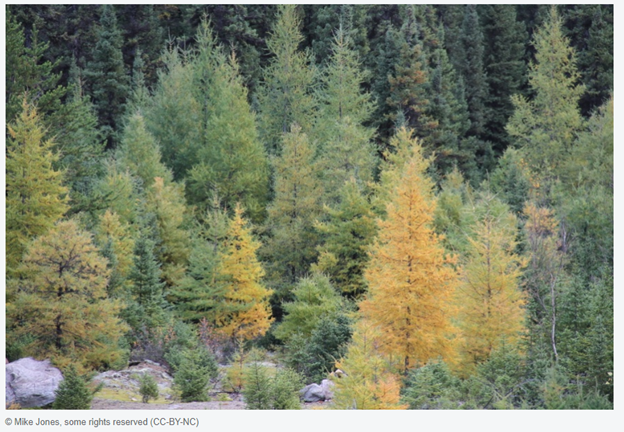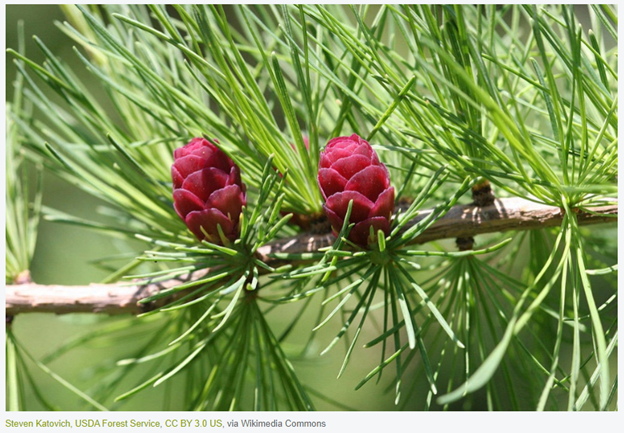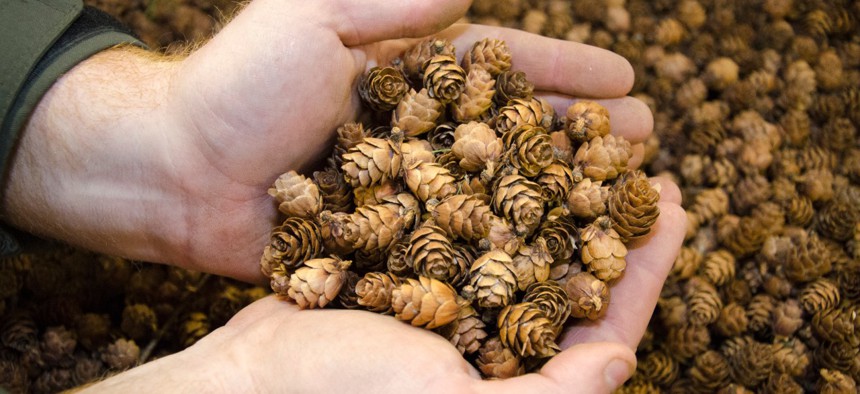
Tamarack trees (larix laricina) – otherwise known as eastern larch or hackmatack) – are long-lived, medium-sized deciduous conifers that grow in every province in Canada.
Interestingly, tamarack is the only conifer that drops its needles in the fall and grows new ones in the spring.
Tamaracks are ideal for landscaping due to their nice shape and the visual interest they add in autumn. This tree species is also highly tolerant of a variety of soil and climate conditions, making it a great choice no matter where you live in Canada!
However, they do require full sun and do not like to be crowded, so this may be an important consideration if you have limited space on your property.
Due to tamarack’s strength, durability, and resistance to rot, it is often used in shipbuilding or for posts, railway ties, and poles that need to stand the test of time. Tamarack bark also contains tannins, which are used for tanning leather.
Learn more about tamarack trees below!
How to Identify Tamarack Trees

Tamaracks can be identified by their trunk/bark, branches/twigs, needles, flowers, and cones.
Trunk/Bark: Smooth and grey when young but turns scaly and reddish-brown as the tree matures. At full maturity, the outer bark is grayer while the inner bark is a reddish-purple.
Branches/Twigs: Feathery and clustered. Orange to pink in colour with a horizontal or slightly ascending growth pattern.
Needles: Soft, flexible, and one to two inches in length. Needles grow in tufts of 10 to 20. Blueish green in the spring and summer, but yellow in autumn.
Flowers: Female flowers are red, while male flowers are yellow-green. Both appear in the spring.
Cones: Small, upright cones 1 to 2 centimeters in size that remain on branches for two years. Reddish-purple when young but brown when ripe.
How Tall Do Tamarack Trees Grow?
The tamarack is a fast-growing tree (2.5 feet per year) that can live for 200-300 years. They reach a height of 30 to 75 feet at maturity, depending on their growing conditions. They generally have a width of up to 30 feet in diameter.
While they can survive in -65 degrees celsius, tamarack trees growing in extremely cold regions may only be around 15 feet tall at maturity – much smaller than ones grown in warmer climates.
Where Do Tamaracks Grow Best?
Tamaracks aren’t very picky when it comes to their growing sites, provided they have constant access to water and sunlight. They prefer moist or wet soil but also do just fine in coarse sand or heavy clay. If they do not have adequate water, tamaracks will struggle to thrive. They also do not do well if there is competing vegetation or too much shade, particularly when they are first trying to get established.
Interestingly, tamarack trees often populate bogs and swamps but also thrive on sites in the boreal forest that have experienced fires. They are also naturally found in mixed wood forests such as the Acadian Forest.
Wildlife Value of Tamarack
The tamarack tree offers wildlife value in terms of providing habitat and shade, though it is not a significant food source for most mammals and birds. However, porcupines will eat the inner bark, squirrels eat the seeds, and snowshoe hares like to feed on tamarack seedlings.
How to Grow Tamarack Trees From Seeds
Collecting seeds from mature tamarack cones and planting them at home is an easy and affordable way to grow this species without purchasing young trees from a nursery. Simply collect cones directly off the tree in the fall before they dry and open. Tamarack seeds can remain viable for a few years before being planted, but mature trees only put out cones every two to six years, so gather a healthy amount if you do not have access to several trees.
Once you have harvested your cones, leave them in a warm, dry location. They will open on their own when they are ready, and you can collect the seeds from inside the scales.
Plan to soak them before cold-stratifying them in your refrigerator for two months in moist sand or soil. Following the stratification period, you can plant your seeds outdoors in pots, a nursery bed, or a spot in the ground that does not have competing vegetation.
Remember that tamaracks like moist soil and full sun, so don’t let them dry out too much. However, they are also susceptible to fungal diseases during their first 4 to 5 weeks, so also prepare to provide them with good draining, healthy soil, and sufficient air circulation. You can fertilize young tamaracks until they are two years old, but following that, they should be quite self-sufficient in the right planting site.

Learn More About Trees and Forest Restoration
Interested in learning more about growing trees at home? Then be sure to visit our Forest Nurseries Restoration Project resources, provided by the Knowlesville Art and Nature Centre and The Tree Project! You can also download our free Community Nurseries guide, which offers helpful information about establishing nursery beds and successfully growing native trees and shrubs.
Want to stay in the loop on upcoming events and learning opportunities? Follow us on Facebook and Instagram!
Fun for the Kids

Listen to “The Tamarack Song” by Halifax-based band, The Wilderbeats!
Through their catchy, unique, interactive music, this fun-loving group aims to fascinate children of all ages with the wonders of nature. They aspire to instill within their fans a deep fondness for Earth, and a personal commitment to be a steward of its well-being.
View the lyrics to “The Tamarack Song” and sing along!
